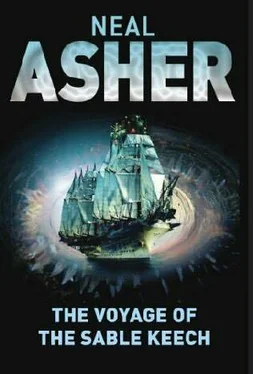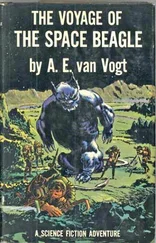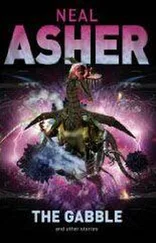Inside it, paper nests grew like bracket fungi from the walls, layer upon layer of them, shelf upon shelf. In here the battle was horribly intense and the floor piled deep with dismembered hornet bodies. The young mind noticed that the hostile hornets were all issuing from one particular conglomeration of nests and, though they were the aggressors, they were losing because the defending nests contained five times their population. But the place contained not just paper nests and drifts of hornet corpses. Fluorescent nano-circuitry adorned the walls, linked to various machines scattered here and in the labyrinth of rooms beyond: furnaces, U-space transmitters, self-contained robotic laboratories and manufactories.
The young mind lost another of its two remaining spies, chopped to pieces by two attackers, that hornet’s vision fading as its severed head fell to the crowded floor. The surviving one, settling on the curved cowling over a manufacturing unit for hornet crystorage boxes, he now fully opened to the surrounding neuro-radio traffic. Insane screaming fed through, along with a viruslike mental program aiming for division, for partition. The youngster swiftly realized this program was no new creation, but in fact one older than the human race. Trying to hold his own sanity together, the young mind attempted to withdraw, tried to shut down the terrifying link. Underneath the screaming he detected a deep sadness—and a decision being made. From one of the slitted windows, a communication laser swivelled on gimbals and began firing. Also, an enclosed lens-shaped autofactory developed hot spots as contained furnaces were deliberately overloaded. Paper nests began to burn. The last com the young mind received from its spy in the bunker was the feeling of mandibles closing between its thorax and its tail, and a wall of flame falling towards it. Meanwhile, from other eyes at a distance, the young mind watched smoke and flame belch from the redoubt.
The old mind had chosen death rather than dissolution.
* * * *
Wiping dust off his gun against his shirt, Janer tried to study its displays even as he ran. He passed Olian Tay, who was leaning against a wall and gazing back towards the vault room, raised a hand to her, then nearly fell flat on his face as Zephyr’s particle-weapon fire lit up ahead of him. No time to pause. He reached the vault room door and stepped through, aiming his gun at Zephyr, looming upright with wings fully spread, turquoise flame blazing from its eyes. He glimpsed Wade over to one side, pressed up against the wall and burning. Then the fire suddenly ceased.
Janer pulled the trigger of his weapon; everything seeming to happen with nightmare slowness.
Too slow.
The Golem creature could move just as fast as Wade, yet it chose not to. Zephyr’s head was turned slightly towards Janer as the singularity generated, encompassing the sail in a collapsing sphere. Then, a light as bright as the sun, a wash of heat, and a blast that flung Janer back out into the corridor. He was slammed against the wall and began to slide down it but, his body already toughened by the Spatterjay virus, he remained conscious.
Why such a blast?
Then he realized: power supplies inside the Golem sail for itself and its weapons. He was lucky the explosion had not taken out the whole building. He lay there for a moment feeling dazed, then reached up tentatively to touch the burns on his face, and to check if there was still any hair on his head. Within the vault room he observed falling ash and gleaming fragments of ceramal scattered across the floor. One distorted claw, which had obviously been outside the sphere, now rested on a pile of charred sprine crystals. He was still staring at that when some blackened object dragged itself slowly around the door jamb.
‘I should not have been fast enough,’ Janer said. ‘It was Golem.’
Wade was missing everything from below his sternum, and his metal bones still glowed at that severance point. His remaining syntheflesh was blackened to a crisp, and fell off in smoking chunks as he moved. He paused, made some clicking and buzzing sounds.
‘You—should—not — havebeen,’ Wade finally agreed, tiny embers glimmering in the air before his mouth, his skeletal jaw making chewing motions.
‘Then why was I faster than a Golem?’
‘Zephyr—wanted — todie.’
‘Seemed reluctant to let you provide that service.’
‘Icould—notkill—me.’
Janer absorbed that and let it go. He realized he was still holding his singun, which he pointed at Wade. ‘Do you want to live?’
‘I—haveto—thereis only—me.’
Janer supposed this was about as much sense as he was likely to get. He holstered his weapon and heaved himself to his feet.
Whelkus Titanicus:
this name applies to just one kind of deep-ocean-dwelling whelk, and should not be confused with the adult forms of frog and hammer whelks which, though large, do not grow to one tenth the size of this behemoth. Titanicus can weigh more than a hundred tons and stand twenty metres high. The pregnant female of this species gives birth to a brood of about a hundred young, and guards them while they feed and grow in the less inimical island shallows. When the youngsters reach a weight of about half a ton, and their shells harden, the mother leads them gradually into the depths. Only 10 per cent survive the journey down to the oceanic trenches. They there feed upon anything available, but their main diet consists of giant filter worms rooted up from the bottom. Virally infected as are most of the other local fauna, the large adults are nearly invulnerable, and it is speculated that specimens of this whelk may be even older than some sails. It is also possible that their survivability is enhanced by either conscious or unconscious control of the viral fibres inside them. This theory was propounded upon the discovery of a small population of these creatures growing the internal digestive systems of herbivorous heirodonts. They did this in a part of the Lamarck Trench recently denuded of fauna by an underwater eruption yet burgeoning with kelp trees thriving on the mineral output of that same eruption. But the adult Whelkus titanicus does not get things all its own way, for it is itself prey to an equally titanic ocean heirodont, and young adult whelks can even be broken open by the large adult hammer whelks—
Captain Orbus walked shakily from the Tank Room and leant on the ship’s rail, staring out across the nighted ocean. After a moment he took hold of what remained of the manacle around his right wrist, pulled hard on it, squeezed and twisted. With a dull crack the ceramal shattered and dropped clattering to the deck. They had only managed to keep him restrained because he had not been in his right mind. Foolish of them to think such flimsy restraints could hold an Old Captain. But what now? Soon someone would notice he was gone and come looking for him, probably with weapons, or with something a bit more potent like Captains Ron, Ambel or Drum. Would he then fight? Would he seek his usual release in violence?
Orbus shook his head, feeling tired and dried up inside. He realized something in him had changed. He looked back upon his life—the long centuries of sadistic brutality and the pointless cyclic nature of it all—and saw it for what it was: a waste. Perhaps now he should end it, cash in his New Skind banknotes for their equivalent weight in sprine and the oblivion that would bring him.
No, no way.
Yes, his life had been a waste up until now. But it did not need to continue that way.
‘Captain…’
Orbus looked round and recognized Silister and Davy-bronte further along the deck from him. They both carried Batian weapons, and both looked scared. Hearing pounding feet from behind, he glanced over that way and saw Forlam and other Hoopers approaching, but slowly enough for Ambel and Drum, coming along behind, to catch them up. He could fight now, then many of them would go over the side to the stripped-fish locker before they brought him down. What havoc and pain he could wreak.
Читать дальше












